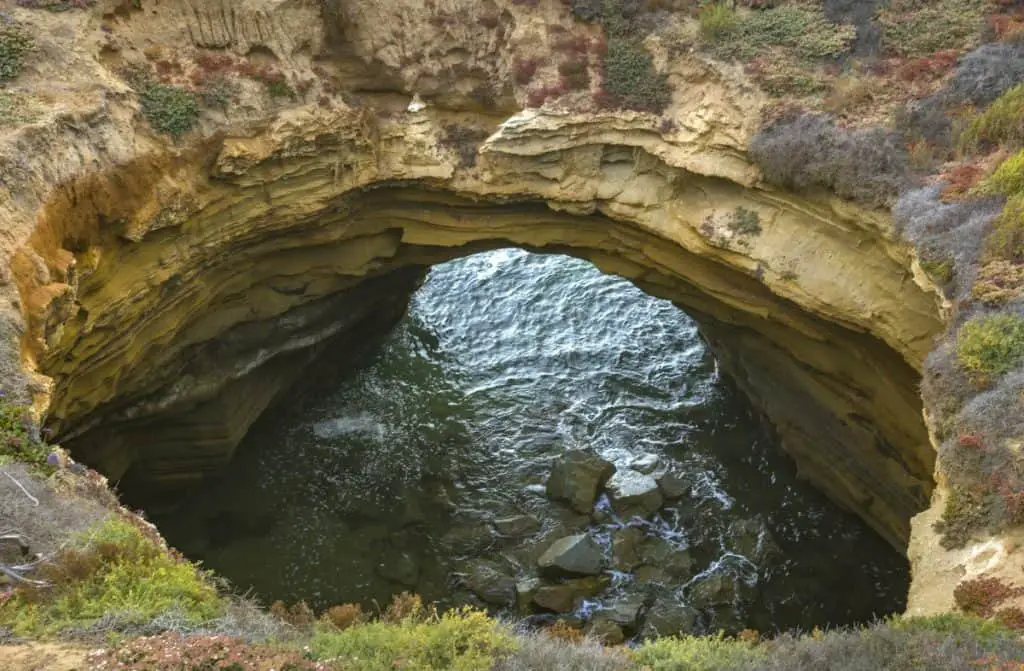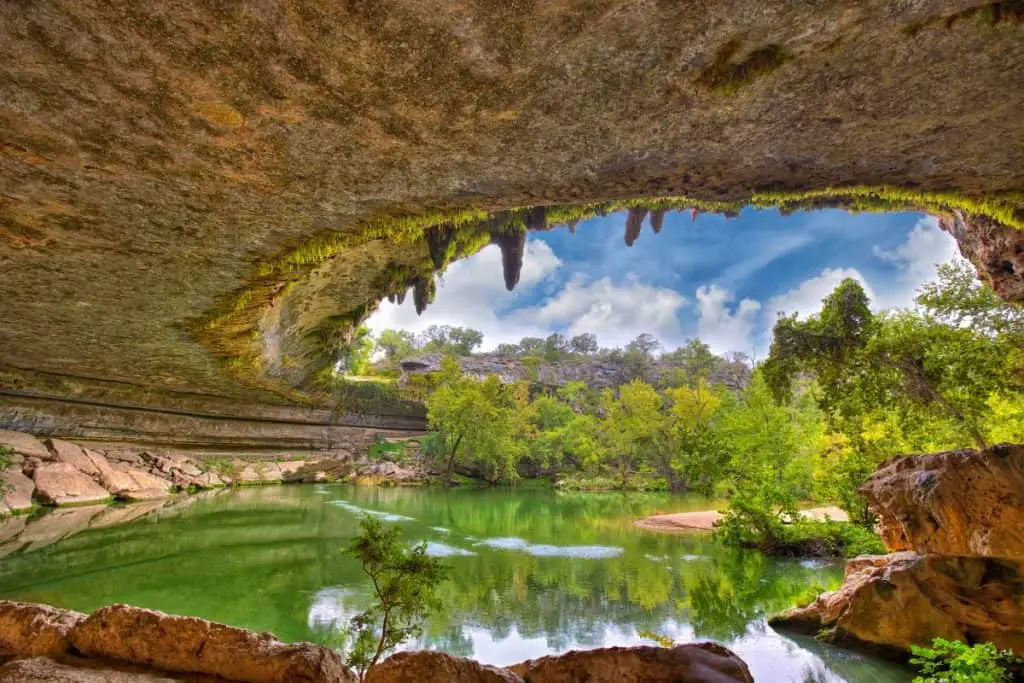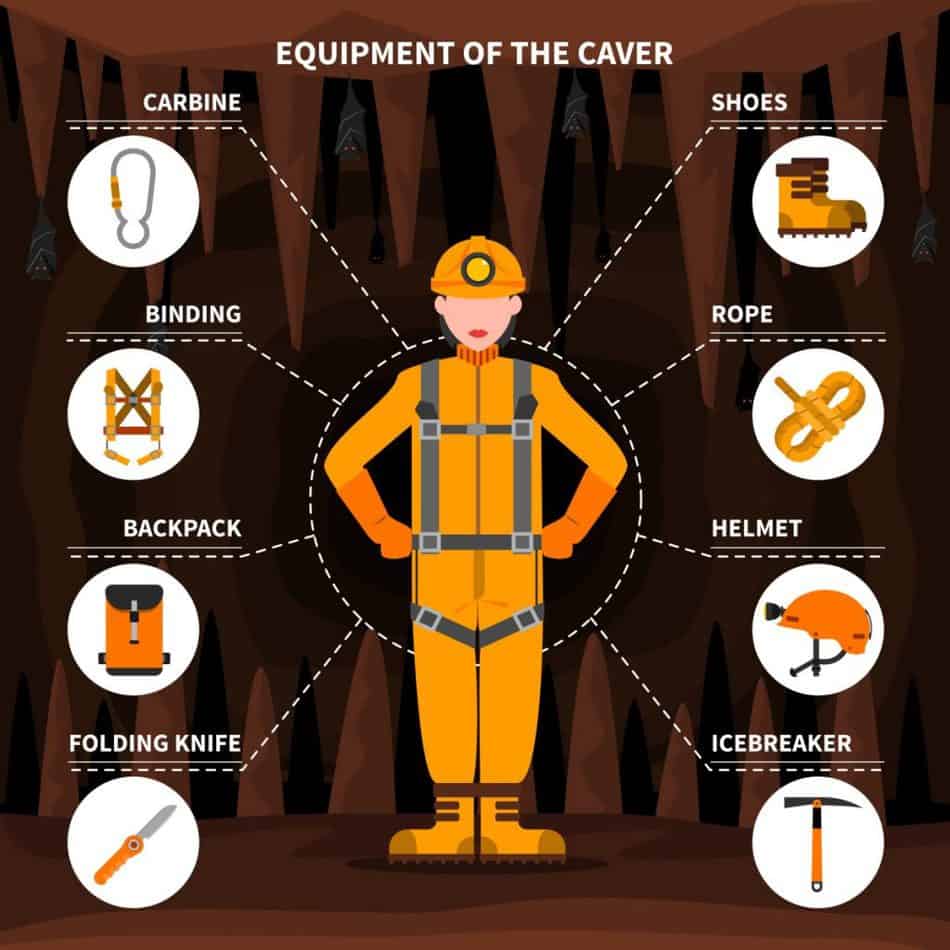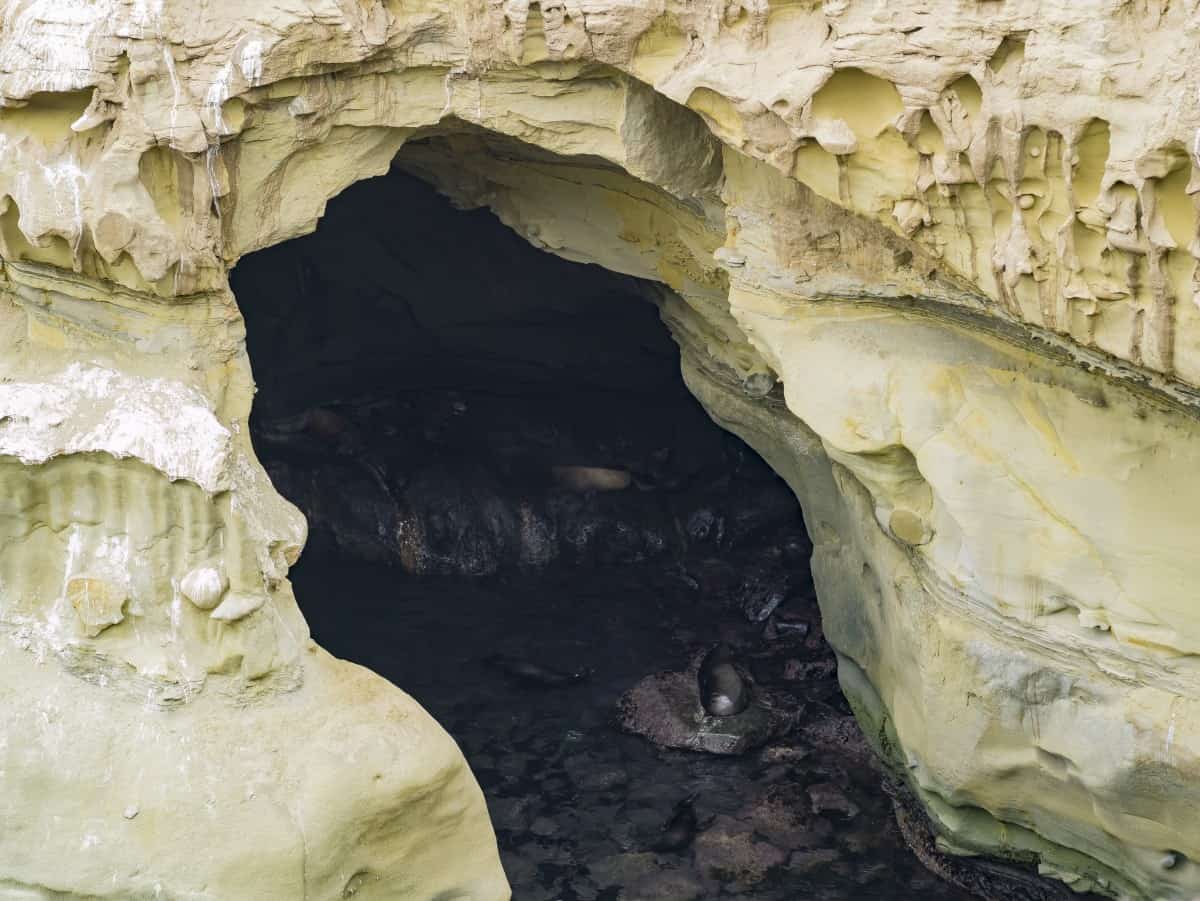Whether it is your first-time cave exploring or you have been doing it for a while, the question comes up; What is the entrance to a cave called? The answer has a lot more to do with the type of cave entrance than it does the shape of the cave opening. There is no one right answer, but several depending on specific characteristics of the cave.
What do you call the entrance to a cave? The entrance to a cave is often called several different things, depending on where you are and the characteristics of the cave.
The following chart gives you an overview of the characteristics and names.
| Location | Vertical | Horizontal |
| Large on land opening | Pit | Yawning( Mouth) |
| Behind the waterfall | Insurgence | Mouth |
| The end of a river | Insurgence | Insurgence |
| The opening to a river (exiting of water) | Re-insurgence | Re-insurgence |
| The surface of a horizontal cave opening | Skylight | N/A |
If you know what kind of cave you plan to explore and where it is, you will know whether you should say you want to go in the yawning or the mouth. Let’s explore the naming options in more detail.
What is the Entrance to a Cave Called?
It depends a lot on the area of the world you live in. In some parts of the world, people call them mouths, but in other places, they are called the entrance. The term mouth is most commonly used as the opening of a cave above ground. However, if you are in Australia, the term Karst is used to describe the entrance to a cave.
Some areas of the world may even refer to the entrance as a Yawning, which means the wide standing opening. It resembles a yawn when the cave entrance is large and open.
Quora user Wookey describes a cave entrance as having many names depending on the formation of the “mouth” and the location. Sink, resurgence, shaft, pothole, sinkhole, or doline are all words used to describe a specific type of entrance into a cave.
An Adit is usually only associated with old abandoned mines. The term Adit is used to describe the entrance to the mine shaft. The access is horizontal and not vertical when using the term adit.

Insurgence versus Resurgence
An Insurgence is an area where water enters a cave, and the resurgence is where the water exits the cave back above ground. They are both used to describe an entrance to a cave. At times cave clubs will enter a cave through the resurgence rather than the insurgence depending on what the exploration is for the day.
It pays to know the entrance and exit points of the cave before exploring it. If you have a plan, you will see where you resurge after exploring the cave. Knowing these things before going on your spelunking adventure will help people know where to start looking if something goes wrong down under.
These two terms are usually used in cave diving, which is one of the most dangerous types of Spelunking around. You need two types of training when cave diving, Cave training, and Diving training. It is easy to get lost and run out of resources inside of a dark cave dwelling.
Usually, an insurgency will be filled with running water and calm water underneath the opening. The water is flowing into the basin, and then out of the bowl. The pond below is what is worth exploring. There can be all sorts of unusual new plants and rock formations that only exists in that single space. Good earth graphics have a beautiful entrance map on their website for KARST entrances worldwide.
Sinkhole or Pothole

These two terms are interchangeable, depending on the place in the world you live in. It describes a large opening in the mouth with a vertical entrance into the cave. Repelling down into the cave is generally the only way to get into the cave.
The Cave of swallows in San Luis Potosi’ Mexico is probably the largest open-pit cave in the world. It has a widening of approximately 994 x 442 ft, and almost 1092 feet deep. The free fall alone down the shallowest part of the cave is known as the pit.
The Cave of Swallows has recently become more popular than ever amongst fellow cave explorers and sports extremists alike. These vertical entrances usually are not as wide as the cave of shallows, which allows for base jumpers to free fall for approximately three seconds before having to release their parachute.
The cave itself is home to birds of the Mexican jungle in vast amounts. The wildlife that lives in the caves, combined with the greenery that grows on the side helps give the cave its fancy name. You can read more about the Cave of Swallows here.
Shaft or Adit
A shaft is usually an entrance to a mine that is either horizontal or vertical. There typically is no bottom to a shaft; it is only the deepest level. The shaft is the entrance and exit from the mine. The mine shaft is the medium between the different levels of the pit.
An Adit is also the opening to a mine shaft but distinctly refers to a horizontal opening to a mine shaft. The decent is usually one that is done primarily on foot and not repelling down a mine shaft hole. Exploring old mines is never recommended and is extremely hazardous.
The Adit is the horizontal opening to a mine shaft; an adit can have multiple mine shafts located inside of it, sometimes covered by old boards or not covered at all. The Us. Federal Government warns that Entering an old abandoned mine is trespassing, and people will be prosecuted.
When you are exploring a mine shaft, you want to be mindful of creatures that can be deadly to you, such as spiders and snakes. You also want to be aware of openings and collapsed areas. You want to be careful not to disturb the environment, moving even one rock could be the difference between making it out and not making it out.
Here is a quick video about old mine exploring.
Bring the Correct Materials for Cave Exploration
If you’re looking to get into caving, or still new, you can check out my comprehensive Beggienrs Guild Here.
You want to make sure that you have the correct materials needed for entering and exiting the cave safely. If you are planning on cave diving, then you are going to need more than a good headlamp.
A rope is always a good idea to bring along with you; you never know when you are going to need a rope, and the rope could be the difference between you getting out of a bind and not. Picking up a good rope to carry with you will only help.
You want to carry extra batteries and food for yourself. You need to bring freshwater or at least a straw filter. You don’t want to drink the water in a cave ever, especially standing water because there is no telling what gases or other elements reside in the water.
Use this chart to help in your next exploration:
| Cave Diving | Mine Shaft | Yawning | Pit Caves | |
| Rope | X | X | X | |
| Water | X | X | X | X |
| Food | X | X | X | X |
| Headlamp | X | X | X | X |
| Oxygen | X | |||
| Water filter | X | X | ||
| Diving suit | X | |||
| Map | X | X | X | X |

Finding Undiscovered Caves
Discovering a new cave can be an exciting adventure if you know how to look for new entrances. Karst is a term used to describe large limestone areas that have underground drainage systems. In other words, caves. There Karst affluent areas throughout the world, and you may be able to find one close to you here on the National Caves Association Website; Of course, it is always helpful to have a Karst Map with you.
You would want to scout the area with a satellite mapping tool such as google earth and look for any areas that may have a cave. If you follow along the Karst lines from your map, then you will find an area worth exploring on foot.
When you’re exploring on foot, you want to look for visible signs of a cave. A good sign is where water is entering the ground in a stream, or where water is coming out of the ground or a sinkhole emerging from the ground. Sometimes leaves, old branches, and twigs will cover up an entrance to a cave.
You can also look for small crevasses in the ground; at times, the rainwater can create a cave at the bottom of pasture if there is a hole in the field. The entrance to the cave may even be covered with grass or look like a simple hole in the ground. (It’s always fun discovering a new cave and finding other people’s ropes that were left behind).
Some things to keep in mind when exploring a new cave is:
- Scout the area via satellite first
- Stay along with massive karst territory
- Check the Local Guidelines and make sure that the region is not protected federal land
- Bring rope, water, food, light, and a Knife with you.
- You want to learn the geology of the area that you are exploring
Here’s a cool video about finding caves. You can also read the article I wrote on How to Actually Find a Cave.
The Three Types of entrance systems
There are three types of cave entrance systems, open, closed, and entrance-less cave dwellings. The entrance-less cave dwelling is not going to be on most people’s list as it requires much heavy equipment to find them and to create an entrance.
Closed entrance caves are caves that have a covered entrance, such as the ones that are covered by rocks and debris. These types of caves are the ones that you can discover the most while hiking around. There are not too many tourist attractions to these closed entrance caves.
Open entrance caves have a prominent, accessible entrance. The entrance is usually visible and easy to access. Sometimes they are inside national parks, or they can be a good attraction for tourists. If you are starting in Spelunking, an open entrance cave would be your best option.
Wild animals will sometimes burrow inside natural caves, and they like closed-off areas to call home. You will find that some of the closed caves are populated with everything from rodents to insects, and even lost cats. You will find all sorts of things inside of caves( I mean that’s half the fun).
How to Find a Cave that is Covered Up
When looking at a map, you want to look for areas that contain anomalies in the growth patterns of the vegetation. For example, a tree line that ends abruptly might be a sign of an opening nearby.
These types of areas are indicators that either a fence line or a sinkhole is present in the area. A sinkhole could potentially be a cave. You may be able to find a stream and follow it to a cave entrance or exit from the terrain. Or it could simply be that the trees ended there because someone had cut them to clear them for pasture or grazing. Further exploration would be necessary.
If you live in a snowy terrain, you may be able to find the caves by looking for signs of heat coming from the cave opening. You can also look for hoarfrost on rocks. Hoarfrost looks like the frost that you would see on the back of older refrigerators where you can see the exposed metal tubing-.
Moss Growth is an indicator that a cave opening is near. The moisture content is enough to support the growth of moss on the outside parts of the cave. Every geological area is going to have its giveaways. Studying the geological region will help you discover new and amazing caves.
Here is a video that shows you how to find caves in your area.
Final Thoughts/Conclusion
Cave exploration is a fascinating hobby. There’s a sense of timelessness of being in a space that seems cut off from the hustle and bustle of the outside world. Remember that no matter whether you enter a mouth, a yawning, or a karst that you know how to get back to it.
“A cave has two great things to teach you: Light is sacred; silence is to integrate with eternity!”
― Mehmet Murat ildan
When you’re ready to get started caving, be sure to read my Beginners Guide and check out my recommended gear section.

